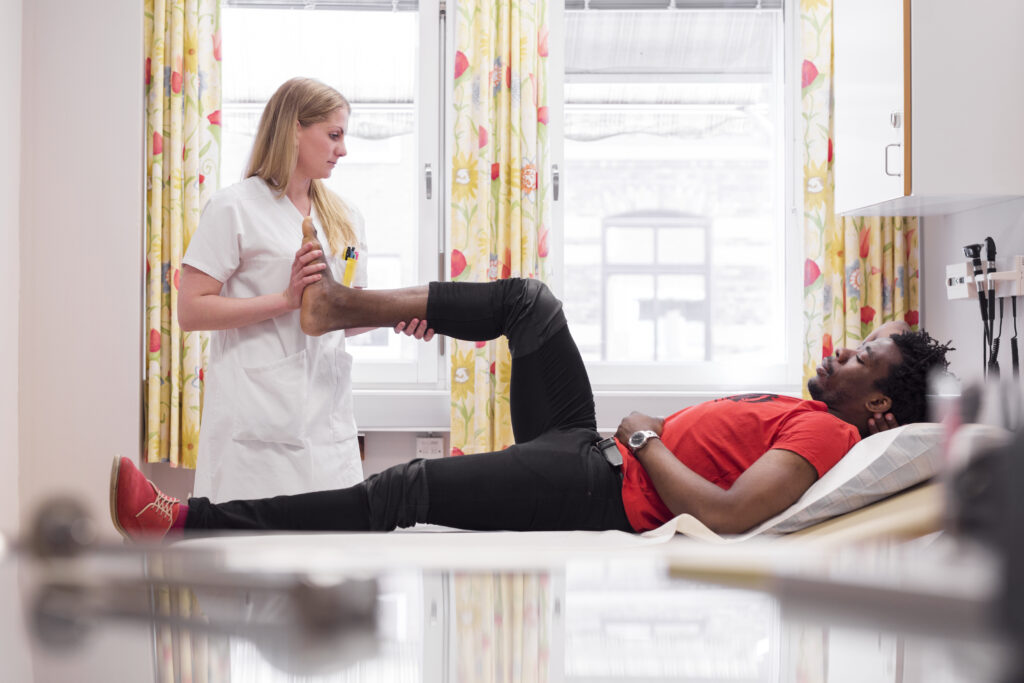Services
Back pain

Back pain
Back pain associated with the spine can be attributed to various spinal conditions, necessitating a comprehensive understanding of both the spine's structure and potential issues. The spine, a complex structure comprising vertebrae, discs, nerves, and supporting structures, is susceptible to conditions like herniated discs, spinal stenosis, and degenerative disc disease, contributing to discomfort. Herniated discs occur when the gel-like substance within a spinal disc protrudes, potentially compressing nearby nerves. Spinal stenosis involves the narrowing of the spinal canal, putting pressure on the spinal cord and nerves.
Nerve and muscle function
Disruptions in nerve and muscle function can result from injuries, diseases, or conditions affecting the nervous system. Conditions like neuropathy or muscular dystrophy can impact these functions, leading to symptoms ranging from weakness and pain to impaired coordination. Addressing such challenges often involves a multidisciplinary approach, including rehabilitation, physical therapy, and medications, to restore and optimize nerve and muscle function. Understanding the intricate relationship between nerves and muscles sheds light on the remarkable coordination that underlies every movement and action in the human body.

Nerve and muscle function

Disruptions in nerve and muscle function can result from injuries, diseases, or conditions affecting the nervous system. Conditions like neuropathy or muscular dystrophy can impact these functions, leading to symptoms ranging from weakness and pain to impaired coordination. Addressing such challenges often involves a multidisciplinary approach, including rehabilitation, physical therapy, and medications, to restore and optimize nerve and muscle function. Understanding the intricate relationship between nerves and muscles sheds light on the remarkable coordination that underlies every movement and action in the human body.
Chronic pain

Chronic pain
Chronic pain, a complex and debilitating condition, extends beyond the typical duration of healing and persists for an extended period, often lasting for months or even years. Unlike acute pain, which serves as a protective mechanism signaling injury or illness, chronic pain can become a persistent and challenging health issue. It can result from various underlying causes, such as injury, inflammation, nerve damage, or conditions like arthritis or fibromyalgia.
Therapeutic Exercises
Therapeutic exercises are vital components of rehabilitation programs, aiding in injury recovery, preventing further complications, and promoting overall health. These exercises are specifically tailored to meet the unique needs and conditions of individuals, addressing specific goals related to strength, flexibility, and functional abilities. Whether recovering from surgery, managing chronic conditions like arthritis, or seeking to enhance overall fitness, therapeutic exercises are designed with precision and consideration for individual circumstances.

Therapeutic Exercises

Therapeutic exercises are vital components of rehabilitation programs, aiding in injury recovery, preventing further complications, and promoting overall health. These exercises are specifically tailored to meet the unique needs and conditions of individuals, addressing specific goals related to strength, flexibility, and functional abilities. Whether recovering from surgery, managing chronic conditions like arthritis, or seeking to enhance overall fitness, therapeutic exercises are designed with precision and consideration for individual circumstances.
Workplace Injuries
Workplace injuries represent a significant occupational health concern, impacting individuals across diverse industries. These injuries can result from a variety of factors, including accidents, inadequate safety measures, and repetitive strain. The consequences of workplace injuries extend beyond immediate physical harm, often leading to financial and emotional challenges for both employees and employers. As such, the prevention and management of workplace injuries are critical aspects of fostering a safe and healthy work environment.

Workplace Injuries

Workplace injuries represent a significant occupational health concern, impacting individuals across diverse industries. These injuries can result from a variety of factors, including accidents, inadequate safety measures, and repetitive strain. The consequences of workplace injuries extend beyond immediate physical harm, often leading to financial and emotional challenges for both employees and employers. As such, the prevention and management of workplace injuries are critical aspects of fostering a safe and healthy work environment.
Ultra Sound

Ultrasound Guided PRP Injection
A non-surgical treatment for tendon and ligament injuries
What is ultrasound-guided PRP injection?
- PRP stands for platelet-rich plasma, a substance derived from your own blood that contains high concentrations of growth factors and healing proteins.
- Ultrasound-guided PRP injection is a procedure that uses ultrasound imaging to deliver PRP directly into the injured tissue, such as a tendon or a ligament.
- The goal of ultrasound-guided PRP injection is to stimulate the natural healing process of the tissue and reduce inflammation, pain, and scarring.
What are the benefits of ultrasound-guided PRP injection?
- Ultrasound-guided PRP injection is a minimally invasive and safe procedure that can be done in an office setting.
- Ultrasound-guided PRP injection can avoid the risks and complications of surgery, such as infection, bleeding, nerve damage, or anesthesia reactions.
- Ultrasound-guided PRP injection can provide faster and more effective recovery than conventional treatments, such as corticosteroid injections, anti-inflammatory medications, or physical therapy.
- Ultrasound-guided PRP injection can enhance the quality and strength of the repaired tissue, reducing the chances of re-injury or chronic pain.
What are the conditions that can be treated with ultrasound-guided PRP injection?
- Ultrasound-guided PRP injection can be used to treat various types of tendon and ligament injuries, such as:
- Achilles tendinitis, a condition that causes pain and inflammation in the back of the heel.
- Rotator cuff tendinitis, a condition that causes pain and inflammation in the shoulder.
- Tennis elbow, a condition that causes pain and inflammation in the outer elbow.
- Golfer’s elbow, a condition that causes pain and inflammation in the inner elbow.
- Plantar fasciitis, a condition that causes pain and inflammation in the bottom of the foot.
- Patellar tendinitis, a condition that causes pain and inflammation in the front of the knee.
- Other conditions that can benefit from ultrasound-guided PRP injection include osteoarthritis, bursitis, and meniscus tears.
How is ultrasound-guided PRP injection performed?
- The procedure of ultrasound-guided PRP injection involves the following steps:
- A small amount of blood is drawn from your arm and placed in a centrifuge, a machine that spins the blood to separate the plasma from the red and white blood cells.
- The plasma is then further processed to isolate the platelet-rich fraction, which contains the highest concentration of growth factors and healing proteins.
- The PRP is then transferred to a syringe and ready for injection.
- The injection site is cleaned and numbed with a local anesthetic.
- An ultrasound probe is placed over the injured tissue, and a needle is inserted through the skin, guided by the ultrasound image.
- The PRP is then injected into the target tissue while the ultrasound monitor confirms the accuracy and distribution of the injection.
- The needle is removed, and a bandage is applied to the injection site.
- The whole procedure takes about 15 to 30 minutes and you can go home the same day.